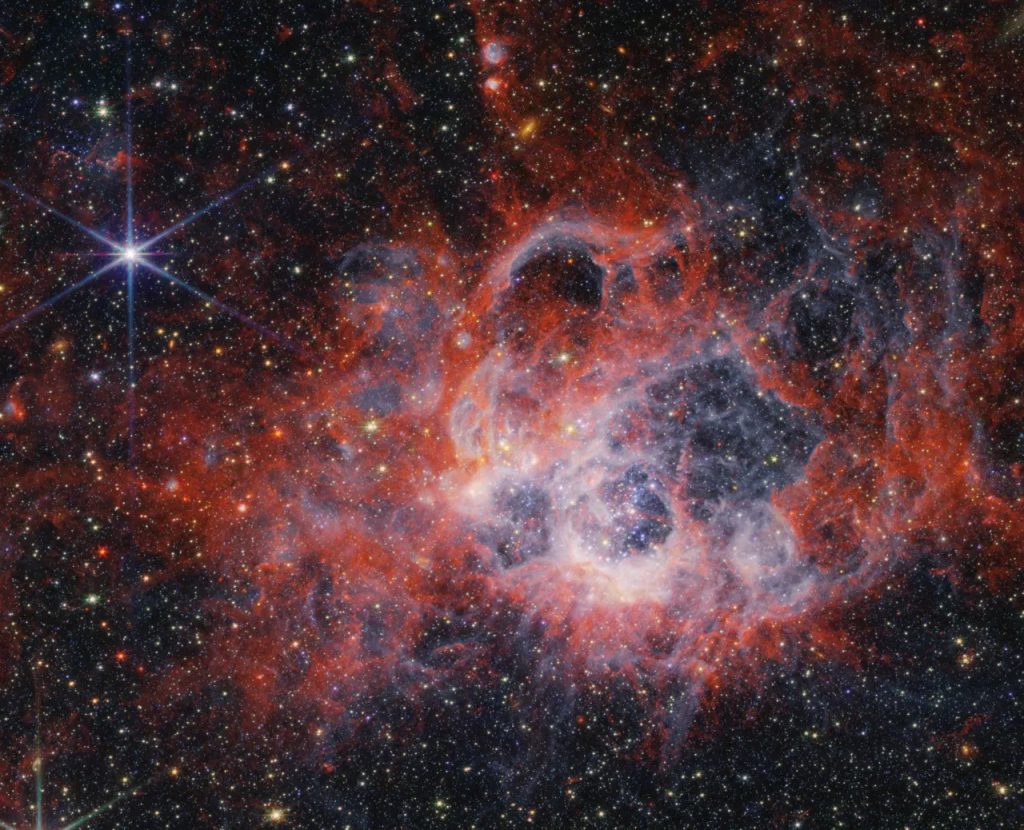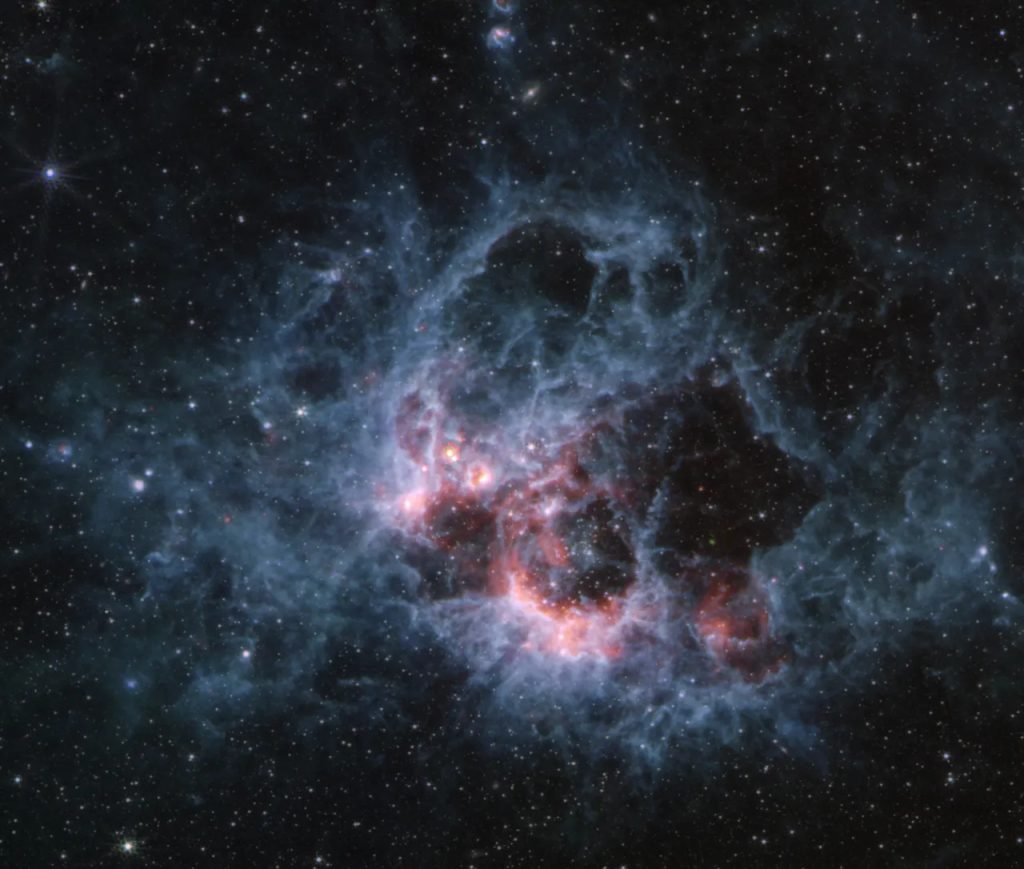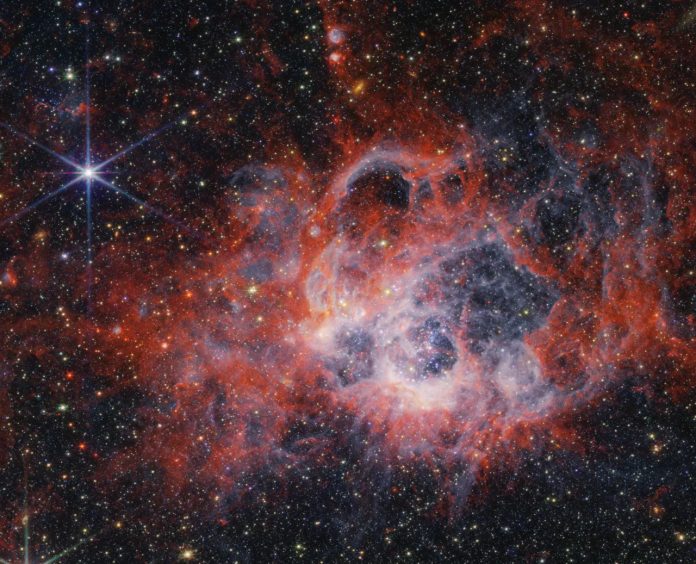James Webb Space Telescope (JWST) has taken near-infrared and mid-infrared images of the star-forming region NGC 604, located nearby in the neighbourhood of home galaxy. The images are most detailed ever and offer unique opportunity to study high concentration of massive, young stars in neighbouring galaxies to our home galaxy, the Milky Way.
The high concentration of massive ດາວ at relatively close distance, means the star-forming NGC 604 offers a unique opportunity to study stars early in their life. Sometimes, the ability to study nearby objects (such as star-forming region NGC 604) at an extremely high resolution can help better understand more distant objects.
ມຸມມອງໃກ້ອິນຟາເຣດ:
This image of NGC 604 is taken by NIRCam (Near-Infrared Camera) of JWST.
Tendrils and clumps of emission that appear bright red, extending out from areas that look like clearings, or large bubbles in the nebula are the most noticeable features of the near-infrared image. Stellar winds from the brightest and hottest young ດາວ have carved out these cavities, while ultraviolet radiation ionizes the surrounding gas. This ionized hydrogen appears as a white and blue ghostly glow.

The bright, orange-coloured streaks signify the presence of carbon-based molecules known as polycyclic aromatic hydrocarbons, or PAHs. This material plays an important role in the interstellar medium and the formation of stars and ດາວເຄາະ, but its origin is a mystery.
The deeper red signifies molecular hydrogen as one travel farther from the immediate clearings of dust. This cooler gas is a prime environment for ດາວ ການສ້າງຕັ້ງ.
The exquisite resolution also provides insights into features that previously appeared unrelated to the main cloud. For example, in Webb’s image, there are two bright, young stars carving out holes in dust above the central nebula, connected through diffuse red gas. In visible-light imaging from Hubble Space Telescope (HST), these appeared as separate splotches.
ມຸມເບິ່ງກາງອິນຟາເລດ:
This image of NGC 604 is by MIRI (Mid-Infrared Instrument) of JWST.
ມີດວງດາວໜ້ອຍລົງຢ່າງເຫັນໄດ້ຊັດໃນມຸມເບິ່ງກາງອິນຟຣາເຣດ ເພາະວ່າດາວຮ້ອນປ່ອຍແສງໜ້ອຍລົງໃນຄວາມຍາວຄື້ນເຫຼົ່ານີ້, ໃນຂະນະທີ່ເມກຂະໜາດໃຫຍ່ກວ່າຂອງອາຍແກັສ ແລະ ຝຸ່ນລະອອງຈະສະຫວ່າງຂຶ້ນ.

Some of the stars seen in this image, belonging to the surrounding galaxy, are red supergiants – stars that are cool but very large, hundreds of times the diameter of our Sun. Additionally, some of the background galaxies that appeared in the NIRCam image also fade.
ໃນຮູບພາບ MIRI, ເສັ້ນສີຟ້າຂອງວັດສະດຸຫມາຍເຖິງການມີ PAHs.
ມຸມເບິ່ງກາງອິນຟາເຣດຍັງສະແດງໃຫ້ເຫັນເຖິງທັດສະນະໃຫມ່ໃນກິດຈະກໍາທີ່ຫຼາກຫຼາຍແລະເຄື່ອນໄຫວຂອງພາກພື້ນນີ້.
ພາກພື້ນສ້າງດາວ NGC 604
The star-forming region NGC 604 is estimated to be around 3.5 million years old. The cloud of glowing gases extends to some 1,300 light-years across. Located 2.73 million light-years away in the nearby Triangulum galaxy, this region is large in extent and contains many more recently formed stars. Such regions are small-scale versions of more distant “starburst” galaxies, which underwent an extremely high rate of star formation.
ໃນຊອງອາຍແກັສທີ່ມີຂີ້ຝຸ່ນ, ມີຫຼາຍກວ່າ 200 ຂອງດາວທີ່ຮ້ອນທີ່ສຸດ, ຂະຫນາດໃຫຍ່ທີ່ສຸດ, ທັງຫມົດໃນໄລຍະຕົ້ນຂອງຊີວິດຂອງເຂົາເຈົ້າ. ດວງດາວຊະນິດນີ້ຄື B-type ແລະ O-type, ອັນສຸດທ້າຍຂອງດວງດາວສາມາດຫຼາຍກວ່າ 100 ເທົ່າຂອງດວງອາທິດຂອງເຮົາເອງ.
ມັນຂ້ອນຂ້າງຫາຍາກທີ່ຈະພົບເຫັນຄວາມເຂັ້ມຂົ້ນຂອງພວກມັນຢູ່ໃນບ່ອນໃກ້ຄຽງ ຈັກກະວານ. In fact, there’s no similar region within our own Milky Way galaxy.
ຄວາມເຂັ້ມຂຸ້ນຂອງດວງດາວອັນມະຫາສານນີ້, ບວກກັບໄລຍະຫ່າງທີ່ຂ້ອນຂ້າງໃກ້ຂອງມັນ, ຫມາຍຄວາມວ່າ NGC 604 ໃຫ້ໂອກາດນັກດາລາສາດໃນການສຶກສາວັດຖຸເຫຼົ່ານີ້ໃນຊ່ວງເວລາທີ່ຫນ້າສົນໃຈໃນຕອນຕົ້ນຂອງຊີວິດ. ບາງຄັ້ງ, ຄວາມສາມາດໃນການສຶກສາວັດຖຸທີ່ຢູ່ໃກ້ຄຽງເຊັ່ນ: ພາກພື້ນທີ່ສ້າງເປັນດາວ NGC 604 ທີ່ມີຄວາມລະອຽດສູງສາມາດຊ່ວຍໃຫ້ເຂົ້າໃຈວັດຖຸທີ່ຢູ່ໄກໄດ້ດີຂຶ້ນ.
***
ເອກະສານ:
ສະຖາບັນວິທະຍາສາດກ້ອງສ່ອງທາງໄກອາວະກາດ (STScI) 2024. ການປ່ອຍຂ່າວ – Peering into the Tendrils of NGC 604 with NASA's Webb. 09 ມີນາ 2024. ມີທີ່ https://webbtelescope.org/contents/news-releases/2024/news-2024-110.html
***






































